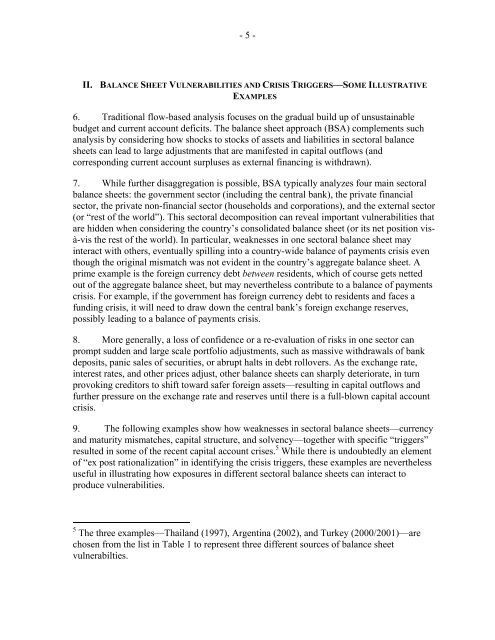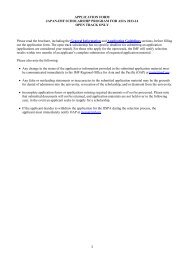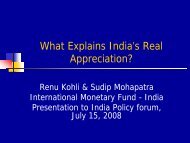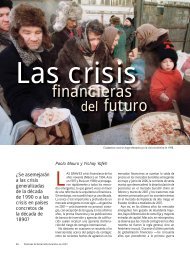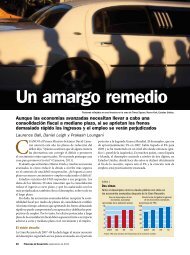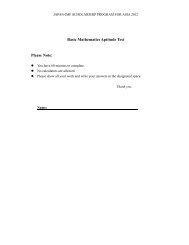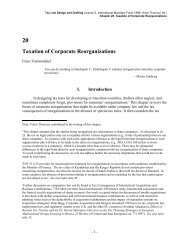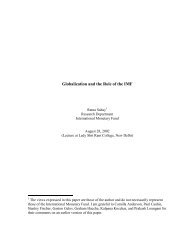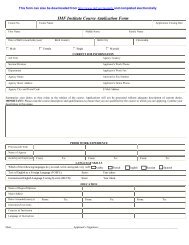Overview of Capital Account Crisis - IMF
Overview of Capital Account Crisis - IMF
Overview of Capital Account Crisis - IMF
You also want an ePaper? Increase the reach of your titles
YUMPU automatically turns print PDFs into web optimized ePapers that Google loves.
- 5 -<br />
II. BALANCE SHEET VULNERABILITIES AND CRISIS TRIGGERS—SOME ILLUSTRATIVE<br />
EXAMPLES<br />
6. Traditional flow-based analysis focuses on the gradual build up <strong>of</strong> unsustainable<br />
budget and current account deficits. The balance sheet approach (BSA) complements such<br />
analysis by considering how shocks to stocks <strong>of</strong> assets and liabilities in sectoral balance<br />
sheets can lead to large adjustments that are manifested in capital outflows (and<br />
corresponding current account surpluses as external financing is withdrawn).<br />
7. While further disaggregation is possible, BSA typically analyzes four main sectoral<br />
balance sheets: the government sector (including the central bank), the private financial<br />
sector, the private non-financial sector (households and corporations), and the external sector<br />
(or “rest <strong>of</strong> the world”). This sectoral decomposition can reveal important vulnerabilities that<br />
are hidden when considering the country’s consolidated balance sheet (or its net position visà-vis<br />
the rest <strong>of</strong> the world). In particular, weaknesses in one sectoral balance sheet may<br />
interact with others, eventually spilling into a country-wide balance <strong>of</strong> payments crisis even<br />
though the original mismatch was not evident in the country’s aggregate balance sheet. A<br />
prime example is the foreign currency debt between residents, which <strong>of</strong> course gets netted<br />
out <strong>of</strong> the aggregate balance sheet, but may nevertheless contribute to a balance <strong>of</strong> payments<br />
crisis. For example, if the government has foreign currency debt to residents and faces a<br />
funding crisis, it will need to draw down the central bank’s foreign exchange reserves,<br />
possibly leading to a balance <strong>of</strong> payments crisis.<br />
8. More generally, a loss <strong>of</strong> confidence or a re-evaluation <strong>of</strong> risks in one sector can<br />
prompt sudden and large scale portfolio adjustments, such as massive withdrawals <strong>of</strong> bank<br />
deposits, panic sales <strong>of</strong> securities, or abrupt halts in debt rollovers. As the exchange rate,<br />
interest rates, and other prices adjust, other balance sheets can sharply deteriorate, in turn<br />
provoking creditors to shift toward safer foreign assets—resulting in capital outflows and<br />
further pressure on the exchange rate and reserves until there is a full-blown capital account<br />
crisis.<br />
9. The following examples show how weaknesses in sectoral balance sheets—currency<br />
and maturity mismatches, capital structure, and solvency—together with specific “triggers”<br />
resulted in some <strong>of</strong> the recent capital account crises. 5 While there is undoubtedly an element<br />
<strong>of</strong> “ex post rationalization” in identifying the crisis triggers, these examples are nevertheless<br />
useful in illustrating how exposures in different sectoral balance sheets can interact to<br />
produce vulnerabilities.<br />
5 The three examples—Thailand (1997), Argentina (2002), and Turkey (2000/2001)—are<br />
chosen from the list in Table 1 to represent three different sources <strong>of</strong> balance sheet<br />
vulnerabilties.


